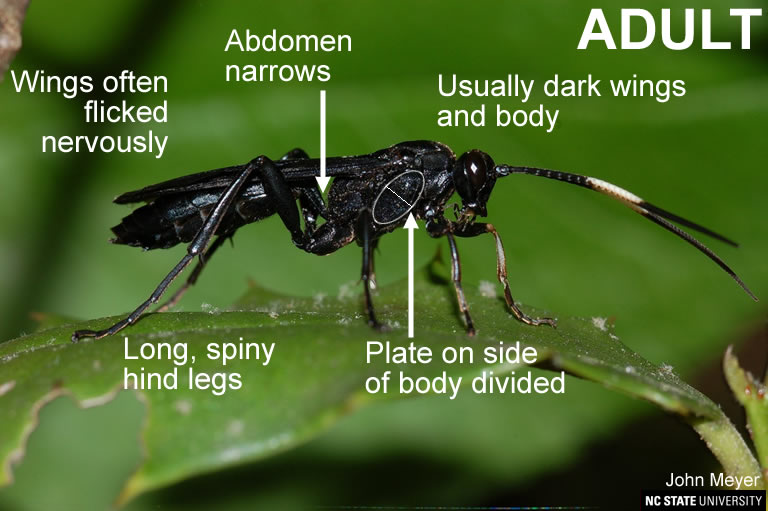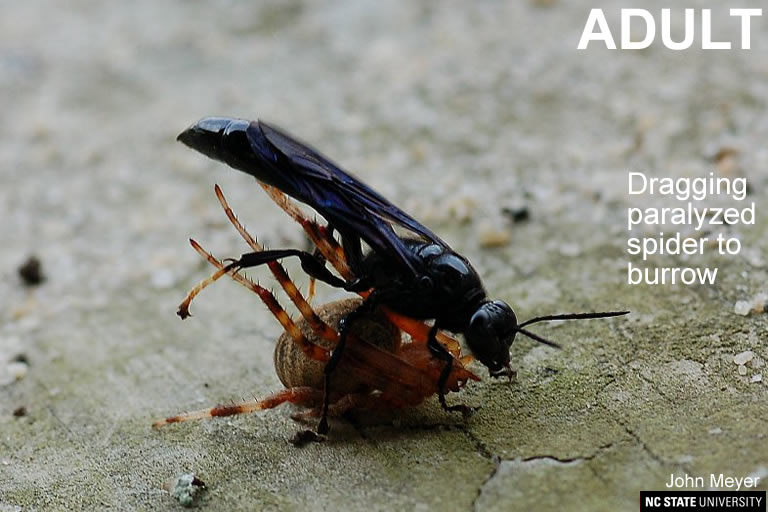Spider Wasp
go.ncsu.edu/readext?563384
en Español / em Português
El inglés es el idioma de control de esta página. En la medida en que haya algún conflicto entre la traducción al inglés y la traducción, el inglés prevalece.
Al hacer clic en el enlace de traducción se activa un servicio de traducción gratuito para convertir la página al español. Al igual que con cualquier traducción por Internet, la conversión no es sensible al contexto y puede que no traduzca el texto en su significado original. NC State Extension no garantiza la exactitud del texto traducido. Por favor, tenga en cuenta que algunas aplicaciones y/o servicios pueden no funcionar como se espera cuando se traducen.
Português
Inglês é o idioma de controle desta página. Na medida que haja algum conflito entre o texto original em Inglês e a tradução, o Inglês prevalece.
Ao clicar no link de tradução, um serviço gratuito de tradução será ativado para converter a página para o Português. Como em qualquer tradução pela internet, a conversão não é sensivel ao contexto e pode não ocorrer a tradução para o significado orginal. O serviço de Extensão da Carolina do Norte (NC State Extension) não garante a exatidão do texto traduzido. Por favor, observe que algumas funções ou serviços podem não funcionar como esperado após a tradução.
English
English is the controlling language of this page. To the extent there is any conflict between the English text and the translation, English controls.
Clicking on the translation link activates a free translation service to convert the page to Spanish. As with any Internet translation, the conversion is not context-sensitive and may not translate the text to its original meaning. NC State Extension does not guarantee the accuracy of the translated text. Please note that some applications and/or services may not function as expected when translated.
Collapse ▲- Common Name: Spider Wasp
- General Category: Parasitoid
- Taxonomic Classification: Hymenoptera: Pompilidae
- Scientific Name: Many species
Description
These are usually large dark-colored wasps, often with dark, oily-looking wings. They are often seen feeding on flower nectar, as well as searching on the ground outdoors, as well as structures such as barns and sheds for spiders. Once they locate a spider, they will paralyze it then either transport it to a previously dug underground nest to lay an egg on it, or lay an egg inside the spiders burrow. You can sometimes observe these wasps dragging paralyzed spiders long distances on the ground. These wasps are solitary, that is a single female will construct and provision a nest.


Identification
Review the images for tips on how to identify these predators.
Adults
Long, often spiny hind legs. Usually very dark body and wings. The wings are not folded up accordion-style at rest as they are in paper wasps. They also often nervously flick their wings, and are very active in searching for spiders and nectar. The middle plate on the side of thorax is divided in two.
Larvae
Because the grub-like larvae develop by feeding on paralyzed spiders in underground nests, they cannot be seen unless a nest is purposely dug up.
Value in Pest Management
Spider wasps contribute to natural control of spider populations. However, because they parasitize spiders, that themselves are considered beneficial arthropods, spider wasps may affect pest management. They are not sold commercially.
Origin and Distribution
Native, throughout North America.


